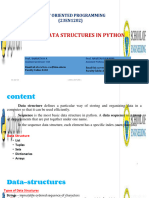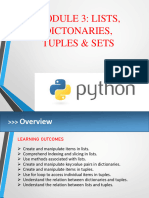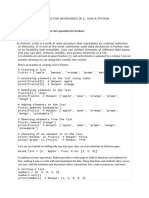0 ratings0% found this document useful (0 votes)
6 viewsPython_Data_Structures
Uploaded by
Garuma AbdisaCopyright
© © All Rights Reserved
We take content rights seriously. If you suspect this is your content, claim it here.
Available Formats
Download as DOCX, PDF, TXT or read online on Scribd
0 ratings0% found this document useful (0 votes)
6 viewsPython_Data_Structures
Uploaded by
Garuma AbdisaCopyright
© © All Rights Reserved
We take content rights seriously. If you suspect this is your content, claim it here.
Available Formats
Download as DOCX, PDF, TXT or read online on Scribd
You are on page 1/ 2
Python Data Structures: Lists, Tuples, and Dictionaries
Lists
A list in Python is a collection of items that is ordered and mutable. Lists allow duplicate
elements and can store items of different data types.
# Example of a list
fruits = ["apple", "banana", "cherry"]
print(fruits[0]) # Output: apple
# Adding an item to a list
fruits.append("orange")
# Removing an item
fruits.remove("banana")
# Iterating through a list
for fruit in fruits:
print(fruit)
Tuples
A tuple is similar to a list but is immutable. Once created, its values cannot be changed.
Tuples are useful for representing fixed collections of items.
# Example of a tuple
coordinates = (10, 20, 30)
print(coordinates[1]) # Output: 20
# Tuples are immutable
# coordinates[1] = 40 # This will raise an error
# Packing and unpacking tuples
x, y, z = coordinates
print(x, y, z) # Output: 10 20 30
Dictionaries
A dictionary in Python is a collection of key-value pairs. Each key must be unique, and
values can be of any data type. Dictionaries are unordered in Python versions < 3.7, but
ordered in Python 3.7 and later.
# Example of a dictionary
person = {"name": "John", "age": 30, "city": "New York"}
print(person["name"]) # Output: John
# Adding a key-value pair
person["job"] = "Engineer"
# Removing a key-value pair
del person["age"]
# Iterating through keys and values
for key, value in person.items():
print(f"{key}: {value}")
Comparison of Lists, Tuples, and Dictionaries
1. **Lists**: Ordered, mutable, and allow duplicate elements.
2. **Tuples**: Ordered, immutable, and allow duplicate elements.
3. **Dictionaries**: Unordered (Python < 3.7), ordered (Python 3.7+), mutable, and consist
of unique keys with associated values.
You might also like
- 1972 - 984 - DOC - Python Data StructuresNo ratings yet1972 - 984 - DOC - Python Data Structures5 pages
- Python Lecture 2 Data Structures in PythonNo ratings yetPython Lecture 2 Data Structures in Python2 pages
- Srinivas Ram Cheat Sheet for Python TopicsNo ratings yetSrinivas Ram Cheat Sheet for Python Topics3 pages
- FALL WIN SEM (2023-24) CSE1012 ETH AP2023243000481 Reference Material I 09-Nov-2023 ListsNo ratings yetFALL WIN SEM (2023-24) CSE1012 ETH AP2023243000481 Reference Material I 09-Nov-2023 Lists4 pages
- Python Collections (Arrays) : Tuple Set DictionaryNo ratings yetPython Collections (Arrays) : Tuple Set Dictionary46 pages
- Week 8: Structured Types - Lists, Tuples, DictionariesNo ratings yetWeek 8: Structured Types - Lists, Tuples, Dictionaries14 pages
- Imp Question - Python Questions by Hari For PlacementNo ratings yetImp Question - Python Questions by Hari For Placement12 pages
- CO1010_ProgrammingforEngineersI_Jun2024_Handout9_ds_427dbaa5cccfd4a62c28ed6d7b5ac1f2No ratings yetCO1010_ProgrammingforEngineersI_Jun2024_Handout9_ds_427dbaa5cccfd4a62c28ed6d7b5ac1f27 pages
- Python Programming Lists Tuples DictionaryNo ratings yetPython Programming Lists Tuples Dictionary53 pages
- Notes_Class_10_Recap_Python_List_Tuples_Dictionary_setNo ratings yetNotes_Class_10_Recap_Python_List_Tuples_Dictionary_set17 pages
- ANCOVA How To Perform An Ancova in PythonNo ratings yetANCOVA How To Perform An Ancova in Python4 pages
































































